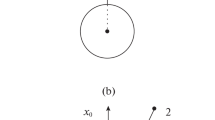Abstract
The process of deployment and transfer to rotation with a given angular velocity of an electrodynamic space tether system in low Earth orbit is considered. The tether system is a linear grouping of three microsatellites connected by current-conducting insulated tethers. The process of forming a tether system is divided into two stages. At the first stage, there is no current in the tether and the relay law for the tension forces is used for the deployment of the system for a given length of the tether. At the second stage, with the help of current control, the system is transferred to a given final state of rotation with a constant angular velocity. To describe the motion of the centers of mass of microsatellites, the Lagrange equations are used. Under the condition of a slow change in tension forces, an analytical estimate was obtained for the characteristics of the angular motion of microsatellites relative to the direction of the tethers. The effectiveness of the considered approach to the formation of a rotating space tether system and the accuracy of analytical solutions are confirmed by numerical examples.





Similar content being viewed by others
REFERENCES
V. V. Beletskii and E. M. Levin, Dynamics of Space Tether Systems (Nauka, Moscow, 1990) [in Russian].
R. Zhong and Z. H. Zhu, “Dynamics of nanosatellite deorbit by bare electrodynamic tether in low earth orbit,” J. Spacecr. Rockets 50 (3), 691–700 (2013). https://doi.org/10.2514/1.A32336
M. Iñarrea, V. Lanchares, A. Pascual, and J. Salas, “Attitude stabilization of electrodynamic tethers in elliptic orbits by time-delay feedback control,” Acta Astronaut. 96, 280–295 (2014). https://doi.org/10.1016/j.actaastro.2013.12.011
K. R. Fuhrhop, PhD Dissertation (Univ. of Michigan, 2007).
Y. Ohkawa, S. Kawamoto, T. Okumura, et al., “Review of KITE-electrodynamic tether experiment on HTV-6,” Acta Astronaut. 177, 750–758 (2020). https://doi.org/10.1016/j.actaastro.2020.03.014
E. M. Levin, Dynamic Analysis of Space Tether Missions (Am. Astronaut. Soc., San Diego, 2007). 453 p.
R. Zhong and Z. H. Zhu, “Optimal control of nanosatellite fast deorbit using electrodynamic tether,” J. Guid. Contr. Dyn. 37 (4), 1182–1194 (2014). https://doi.org/10.2514/1.62154
M. Iñarrea, V. Lanchares, A. I. Pascual, and J. P. Salas, “Attitude stabilization of electrodynamic tethers in elliptic orbits by time-delay feedback control,” Acta Astronaut. 96, 280-295 (2014). https://doi.org/10.1016/j.actaastro.2013.12.011
X. Zhou, J. Li, H. Baoyin, and V. Zakirov, “Equilibrium control of electrodynamic tethered satellite systems in inclined orbits,” J. Guid. Contr. Dyn. 29 (6), 1451–1454 (2006). https://doi.org/10.2514/1.21882
P. S. Voevodin and Yu. M. Zabolotnov, “Stabilizing the motion of a low-orbit electrodynamic tether system,” J. Comput. Syst. Sci. Int. 58 (2), 270–285 (2019). https://doi.org/10.1134/S1064230719020175
P. S. Voevodin and Yu. M. Zabolotnov, “Analysis of the dynamics and choice of parameters of an electrodynamic space tether system in the thrust generation mode,” Cosmic Res. 58 (1), 42–52 (2020). https://doi.org/10.1134/S0010952520010062
X. Chen and J. R. Sanmartín, “Bare-tether cathodic contact through thermionic emission by low-work-function materials,” Phys. Plasmas. 19, 1-8 (2012). https://doi.org/10.1063/1.4736987
G. Sánchez-Arriaga, C. Bombardelli, and X. Chen, “Impact of nonideal effects on bare electrodynamic tether performance,” J. Propul. Power. 31 (3), 951–955 (2015). https://doi.org/10.2514/1.B35393
V. M. Kulkov, Yu. G. Yegorov, and S. A. Tuzikov, “Investigation of integral energy characteristics of the space electrodynamic tether system designed for orbital experiments,” Izv. Akad. Nauk, Energetika, No. 3, 114–127 (2017).
V. M. Kulkov, Yu. G. Yegorov, and S. A. Tuzikov, “Study of configuration and creation of concept design for the deployed space electrodynamic tether system as a part of orbital spacecraft,” Izv. Akad. Nauk, Energetika, No. 3, 119–130 (2018). https://doi.org/10.7868/S0002331018030123
S. A. Ishkov and S. A. Naumov, “Control over orbital tether system unfolding,” Vestnik Samar. Gos. Aerokosm. Univ. 5 (1), 77–85 (2006).
M. Kruijff, Tethers in Space (Delta-Utec Space Research, Netherlands, 2011).
Yu. M. Zabolotnov, “Dynamics of the formation of a rotating orbital tether system with the help of electro-thruster,” Procedia Eng. 185, 261–266 (2017). https://doi.org/10.1016/j.proeng.2017.03.339
P. S. Voevodin and Y. M. Zabolotnov, “On stability of the motion of electrodynamic tether system in orbit near the Earth,” Mech. Solids 54, 890–902 (2019). https://doi.org/10.3103/S0025654419060050
Y. M. Zabolotnov and O. N. Naumov, “Motion of a descent capsule relative to its center of mass when deploying the orbital tether system,” Cosmic. Res. 50, 177–187 (2012). https://doi.org/10.1134/S0010952512020098
Fundamentals of the Theory of Spacecraft Flight, Ed. by G. S. Narimanov and M. K. Tikhonravov (Mashinostroenie, Moscow, 1972) [in Russian].
Y. M. Zabolotnov, “Application of the integral manifold method to the analysis of the spatial motion of a rigid body fixed to a cable,” Mech. Solids 51, 371–384 (2016). https://doi.org/10.3103/S0025654416040014
L. D. Landau and E. M. Lifshits, Theoretical Physics, Vol. 1: Mechanics (Nauka, Moscow, 1988) [in Russian].
Yu. M. Zabolotnov, “The resonance motions of a statically stable Lagrange top at small nutation angles,” J. Appl. Math. Mech. 80 (4), 302–310 (2016). https://doi.org/10.1016/j.jappmathmech.2016.09.004
Funding
The study was financially supported by the Russian Foundation for Basic Research and the SFES of China within the framework of the scientific project no. 20-51-53002.
Author information
Authors and Affiliations
Corresponding authors
Additional information
Translated by I. Katuev
About this article
Cite this article
Zabolotnov, Y.M., Voevodin, P.S. & Hongshi, L. A TWO-STAGE METHOD FOR THE FORMATION OF A ROTATING ELECTRODYNAMIC SPACE TETHER SYSTEM. Mech. Solids 57, 462–475 (2022). https://doi.org/10.3103/S0025654422030232
Received:
Revised:
Accepted:
Published:
Issue Date:
DOI: https://doi.org/10.3103/S0025654422030232




